#William S. Beardsley
Text
Iowa Governor DILFs


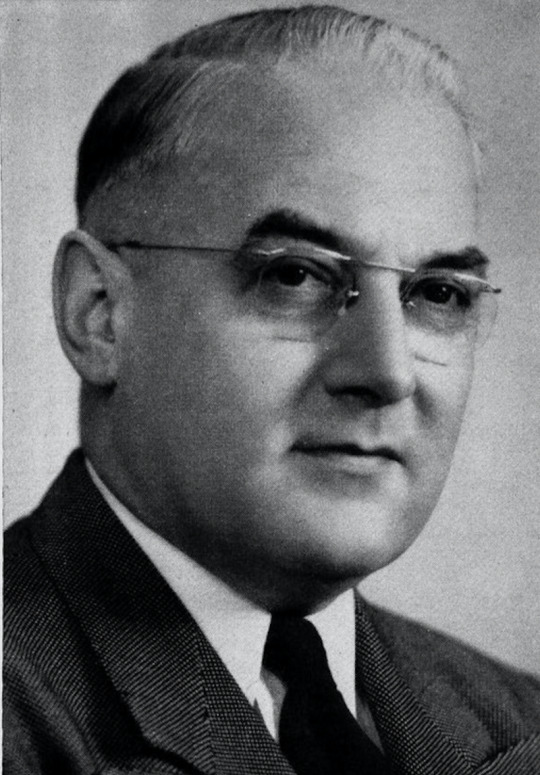
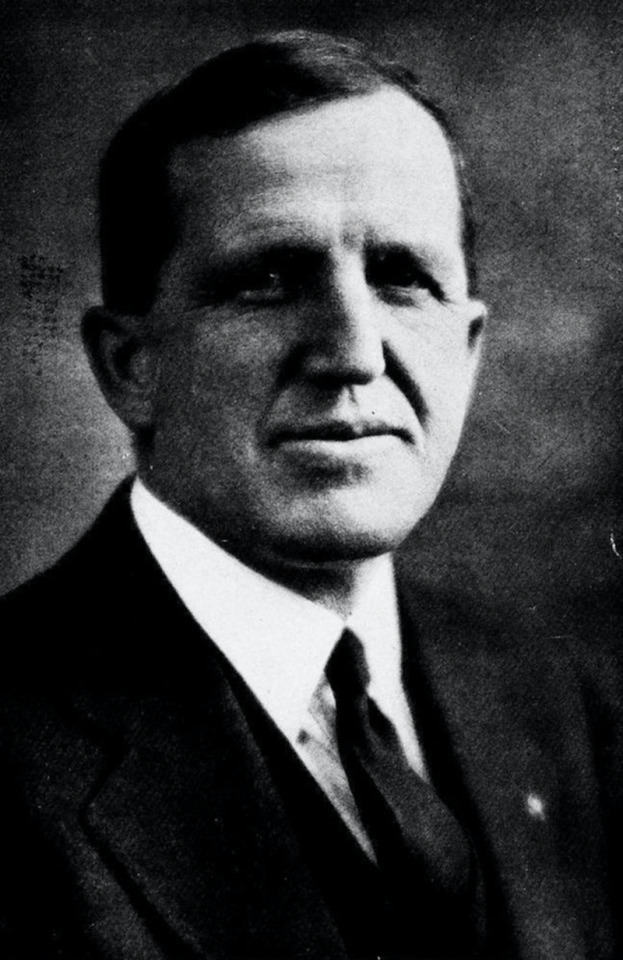






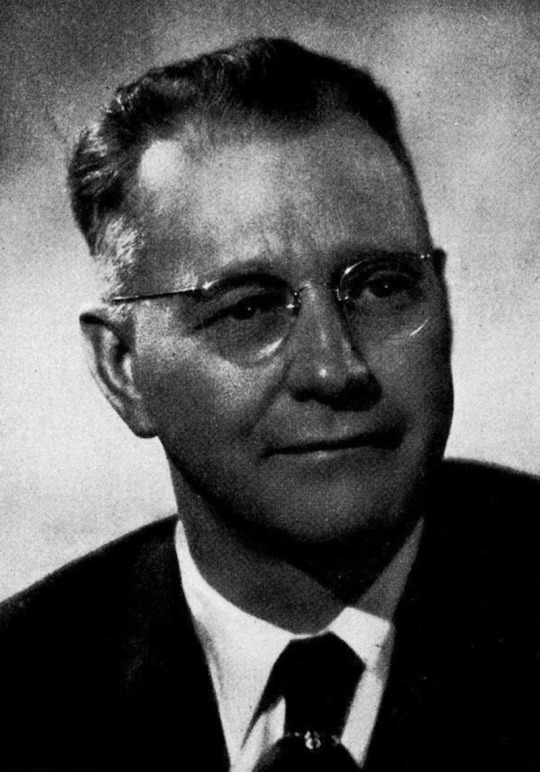

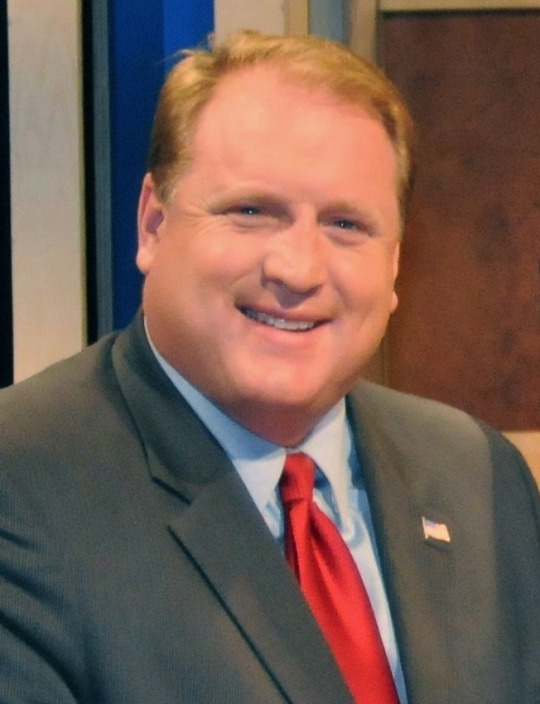
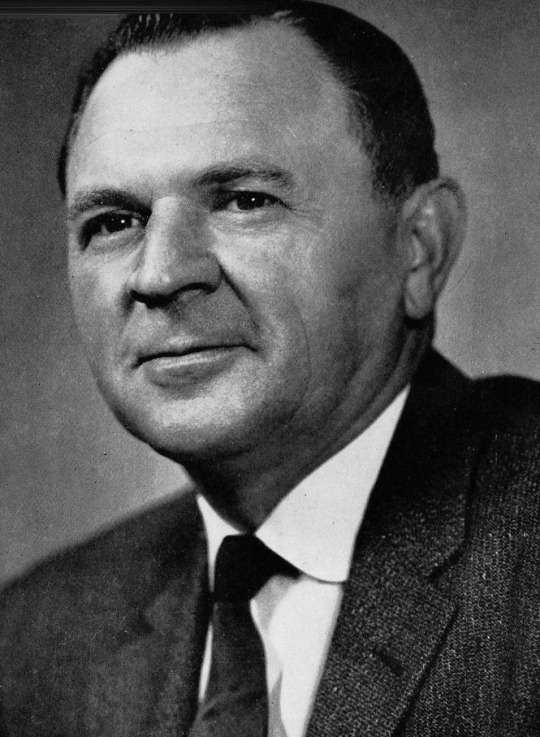
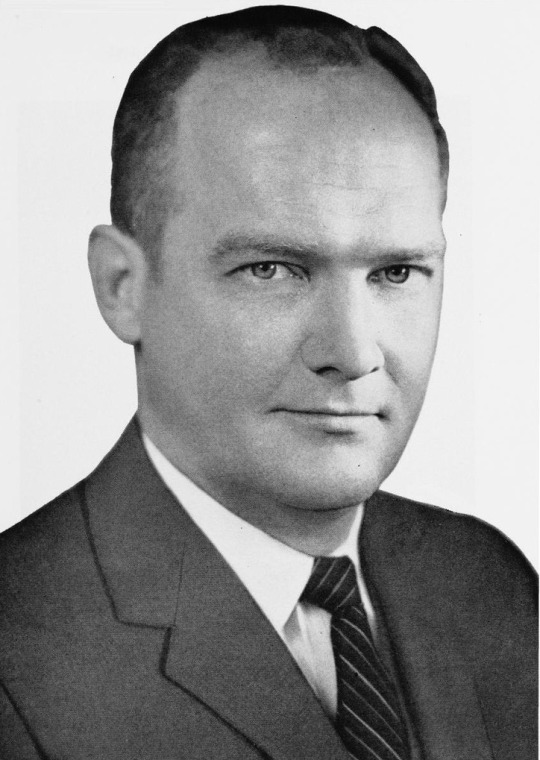



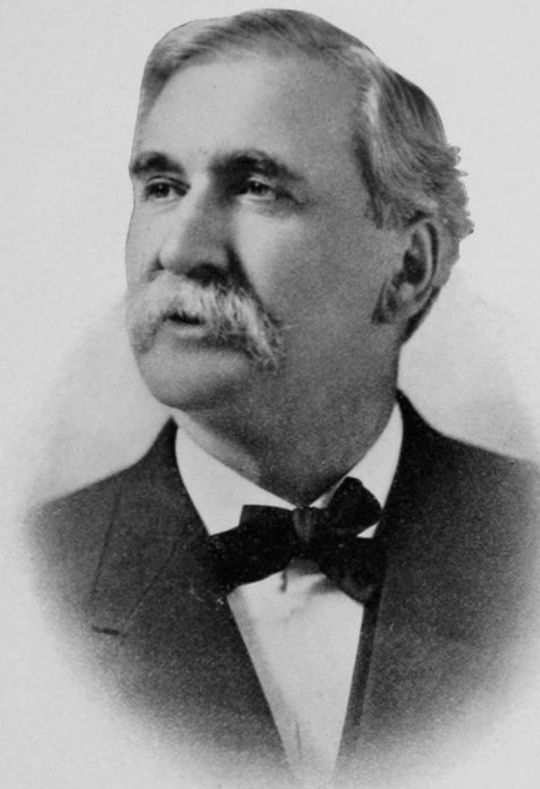
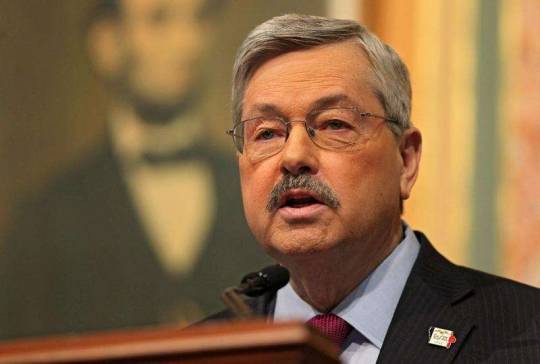
Belated Governor DILF entry that I started doing on the day of the caucus.
#Tom Vilsack#Bourke B. Hickenlooper#Beryl F. Carroll#L.M. Shaw#Clyde L. Herring#Dan W. Turner#George A. Wilson#Francis M. Drake#William S. Beardsley#Chet Culver#Harold Hughes#Horace Boies#Herschel C. Loveless#Leo Elthon#Leo Hoegh#Norman A. Erbe#Robert D. Blue#Robert D. Ray#Terry Branstad#Warren Garst#GovernorDILFs
14 notes
·
View notes
Note
hi! i recently subscribed to the pateron, and im a little intimidated by all of the extra content available, lol. in your opinion, what are some of the funniest short rest / dungeon court / mixed bag episodes to start with? (if anyone else also has their fave eps to share please do)
oh wonderful! welcome to the best stupid show(s) money can buy.
i’m gonna operate under the assumption you’re caught up on main feed eps but if i suggest a short rest for an episode you haven’t listened to, definitely hit the episode first.
these are just off the top of my head with ones i can remember what they are, i may come up with more later lol
short rests:
i think short rests 99 and 100 should actually be required listening for everyone, they’re fucking earth shattering. start there.
the one for 70 is stupid and reveals how they almost lost the episode so that’s a good one.
c3e22 has one of the most insane short rests in retrospect. and c3e41 also has a bonkers short rest. they talk about santa manscaping in your bathroom. the episode came out in august. i wept.
c2e41’s campaign wrap up short rest also is a good time and gives good insights on the campaign.
the short rest for the can they kill it is the origin of crabster. 77 has a rose before noon. 91 ends with jake saying something so insane it ruins me.
the short rest for caldwells frooze your own adventure also slaps. the wilson brothers are there.
the brussels hookup is another 8bbc short rest that’s so dumb and beautiful.
c3e54 has them all hyped up on too much caffeine after a mixed bag and talking about jumping off decks onto frozen lakes and landing on one boob and one butt cheek. i wish i was kidding. it’s incredible.
dungeon courts:
i’m mostly gonna highlight patreon dungeon courts with the assumption you’ve listened to the corresponding main feed eps.
king robert can klump ft. ally beardsley. the flintstones costume fun around the house. you don’t know what that means but it’s. something.
a little place called mangia’s. murph breaks down. caldwell loses it. jake turns to google.
yuncle ft. jasper william cartwright. rats ride loose and your yuncle is power hungry.
the video dungeon courts are great, you can see murph lose it.
bird jail ft. zac oyama. actually anything with zac oyama. it’s great.
table rattlers ft. jeremy cobb. i don’t remember what happens exactly but it’s great.
the dm’s judge ft. lou wilson and zac oyama. absolutely iconic bench on this one.
mixed bags:
mixed bag tier my beloved!! so many are so good!
the whole blazing babe chronicles. not enough people know there was a second hot boy summer campaign that’s available on the mixed bag. caldwell spills half a corona on his character sheet. it’s a dry july and the boys are Not on the same page about it. love is love is love returns.
the biggest loreser is new but damn if it isn’t impeccable. warning: the fred flintstone noise is fucking LOUD
all the taste tests (energy drinks, m&ms, and gamer energy drinks). jake tries an expired products. jake later forgets to buy peanut m&ms while emily decides she can taste what color an m&m is. murph gets hyped on caffeine and has to take a break resulting in one of the most insane short rests to date. listen to the short rest first, it’s funnier that way.
if you can listen to live shows, (the sound is sometimes challenging) i recommend those. great starting point is the melbourne one from last year, i laughed so much the first time i heard it. “i was a lurking actor. that’s a union job!” also the boston dungeon court did hit the main feed but started as a mixed bag and i was there so i want to shout it out.
emily’s winter solstice one shot!! brennan and siobhan are there and it’s creepy and truly so fun.
both dungeons and dragons movies. jake and emily gaslight murph. they talk about a truly terrible set of films. there’s someone called grape lady that is a highlight.
both spilltaculars. at times a bit cringe, but it’s fun to hear other people’s failures sometimes because then you feel better about yourself. plus they make up a judgement scale that is different every time.
spellcheck! the game show that’s kinda sweeping the nation. or was. it’s fun.
that’s long (oops) and all i can think of off the top of my head. if people have other faves, share them for new patreon people!
also, my last bit of advice is to join the streams if you can. jake’s stream is for the short rest tier and above and caldwells is for the mixed bag tier and above. they’re wild. we had caldwell drawing everyone in crocs for like 6 months (it’s arguably why we’re getting the jibbitz). sometimes you get tucker lore. (tucker, the fictional man jake’s wife is cucking him with.) they’re grand.
81 notes
·
View notes
Text
surprised this wasn't hiding in the spreadsheet before but here goes.
seating chart by player + d20's gender splits
this one came mostly from analysis of old data--instead on the cast appearances chart, here's where everyone sat during their full seasons (oneshots are not counted here to reduce their impact as outliers)

as you'll notice, the data is repeated for the intrepid heroes sequel seasons because they were not made at the same time and this allows me to standardize and check how many people have sat in each seat more easily. also, it would mean i'd have to count everyone for each seat once, and i'm not planning on doing that right now. anyways.
for my splits:
first off, disclaimer that gender is a societal construct and that you can do whatever you want with it so long as you don't harm others. this list uses the pronouns indicated by the cast members. this list goes by the cast members' current gender--retroactively effective. if they came out after the season aired, they're still listed with their gender at the time of posting (Jan-Feb 2024).
for the sake of simplicity and not making separate categories for every nb cast member my categories are female (she/her pronouns), male (he/him), and nonbinary/gnc (they/them, other combinations of pronouns), which encompasses more complex combinations. yes the drag queens are split up because it's based on their pronouns as indicated. not everyone in the gnc group uses the same pronouns, so nonbinary/gnc is in use as an umbrella term.
so without further ado:
overall gender statistics
out of 48 cast members of dimension 20, there were 20 in the she/her category, 21 in the he/him category, and 7 in the nonbinary pronouns category
female (she/her): emily axford, siobhan thompson, rekha shankar, amy vorpahl, jessica ross, lily du, marisha ray, krystina arielle, aabria iyengar, katie marovitch, danielle radford, becca scott, persephone valentine, isabella roland, dani fernandez, jasmine bhullar, anjali bhimani, alaska thunderfuck, jujubee, rashawn nadine scott
male (he/him): brennan lee mulligan, zac oyama, lou wilson, brian murphy, matthew mercer, mike trapp, ify nwadiwe, justin mcelroy, clint mcelroy, griffin mcelroy, travis mcelroy, carlos luna, b. dave walters, sam reich, raphael chestang, grant o'brien, omar najam, oscar montoya, freddie wong, hank green, jasper william cartwright
nonbinary/gnc: ally beardsley (they/them), erika ishii (all pronouns), gabe hicks (he/they), surena marie (she/they), monét x change (she/her/he/him), bob the drag queen (he/him/she/her), alex song-xia (they/them)
in other words the ratio of cast members is 41.6% female, 43.75% male, and 14.58% nonbinary/other genders
the main cast i.e. the intrepid heroes + brennan is a little less even, since brennan shifts the group toward a male bias (4/7, vs 2/7 female and 1/7 nonbinary)
so a pretty even split wrt gender and pronoun usage overall. some seasons differ in composition, but generally there's a pretty even split (female/male/gender non-conforming) with the GM tipping the balance.
gender stats by season
all of the intrepid heroes seasons (fantasy high, the unsleeping city, fantasy high sophomore year, a crown of candy, the unsleeping city chapter ii, a stasrtruck odyssey, neverafter, fantasy high junior year) are 57.1% male, 28.5% female, and 14.2% nonbinary [4, 2, 1]
escape from the bloodkeep: same breakdown as the intrepid heroes seasons: 57.1% male, 28.5% female, and 14.2% nonbinary [4, 2, 1]
tiny heist: a stronger majority this time since the mcelboys and their dad are there: 71.4% male, 28.5% female [5, 2]
pirates of leviathan: similar to ih breakdown; 57.1% male, 42.8% female [4, 3]
mice & murder: maintains the intrepid heroes split of 57.1% male, 28.5% female, and 14.2% nonbinary [4, 2, 1], with ally holding the last category.
misfits & magic: with only 5 people there's an almost even split; 40% female, 40% male, 20% gnc [2, 2, 1]
the seven: our season of ladies; 71.4% female, 14.2% nonbinary, 14.2% male [5, 1, 1]
shriek week: another almost even season; 40% female, 40% gnc, 20% male [2, 2, 1]
coffin run: another 5-person season; 40% female, 40% male, 20% gnc [2, 2, 1]
a court of fey and flowers: follows the ih split; 57.1% male, 28.5% female, and 14.2% nonbinary [4, 2, 1]
the ravening war: 6 person season, so we're looking at 66.6% male, 33.3% female [4, 2]
dungeons and drag queens: this season is a little tricky since the players are simultaneous performing in drag, but using their listed pronouns we get the general split; 40% female, 40% gnc, 20% male [2, 2, 1]
mentopolis: also follows the intrepid heroes split: 57.1% male, 28.5% female, and 14.2% nonbinary [4, 2, 1]
burrow's end: the intrepid heroes split in the opposite direction; 57.1% female, 28.5% male, and 14.2% nonbinary [4, 2, 1]
for our 7 person seasons, the most common split is the intrepid heroes split, of 57.1% male, 28.5% female, and 14.2% nonbinary [4, 2, 1]. This pattern goes for 12/21 seasons of dimension 20. otherwise we tend to lean to one direction or another.
for the 5 person seasons, there's a pattern of a 2, 2, 1 split, but it's evenly split between [f, m, gnc] and [f, gnc, m].
gender splits in the seating chart
for the seating chart, it's a little different. there's two ways of tallying this up; by season or by cast member. the critical difference being that the latter does not allow repeats (of the intrepid heroes generally but also other returning cast) while the former does. i suppose the other way of stating it would be that we can count it up by occurrence or by total number.
since i don't feel like calculating percentages for this set, they will be displayed as ratios, like so: [F:M:NB]. keep in mind that some seats are not used for all seasons, so the numbers that the ratios add up to will differ.
L1: by occurrence, L1 has a 9:9:3 ratio with repeats, and 7:6:3 by total number of cast, so ever so slightly female-biased
L2: by occurrence, L2 has a 7:8:1 ratio with repeats, and 5:6:1 by total number of cast, so ever so slightly male-biased
L3: by occurrence, L3 has a 11:8:2 ratio with repeats, and 8:5:2 by total number of cast, so strongly female-biased
R3: by occurrence, R3 has a 9:9:3 ratio with repeats, and 4:6:3 by total number of cast, so male-biased. the difference in total number comes from the fact that siobhan, aabria, and lily all sit in R3 on multiple occasions
R2: by occurrence, R2 has a 2:9:6 ratio with repeats, and 2:7:2 by total number of cast, so male-biased with a strong nb/gnc presence. the drop comes from ally and erika both sitting there multiple times
R1: by occurrence, R1 has a 6:11:4 ratio with repeats, and 6:8:3 by total number of cast, so strongly male-biased. as you can probably guess, the difference comes from murph sitting in his favorite seat.
GM: by occurrence, we're looking at a 4:16:1 ratio, but a 2:2:1 by total number. if you account for the fact that brennan, the in-house gm, has been in the hot seat for 15 seasons, this makes more sense.
and that's all for this time! quick question for next time:
you can find the spreadsheet here: seating chart by player. as always, feel free to peruse, and check out the ao3 compilation to see all the stats in one place.
#dimension 20#dimension 20 spoilers#dimension 20 meta#thisisnotthenerd's d20 stats#dimension 20 statistics#intrepid heroes#d20 poll#d20 spoilers#gender#shouls i make a sub-tag of the seating charts?#maybe i'll do that#the number has gotten kind of unwieldy at this point#i really should start splitting these into different spreadsheets
9 notes
·
View notes
Note
This might he an invasive question, you don't have to answer just ignore if you don't feel like sharing so much of yourself!
But I just love the darkness and intensity of what you post, it's what I am drawn to most in this world and so I was wondering what are your inspirations? Your favorite artworks? Music/songs? Are there any particular artists from the past long go or present that you like in terms of what they have to say, saying something new!!!
I just have to mention that I have fallen inlove with Marilyn Monroe recently and I love her poetry 'fragments' I especially love her thoughts she gives in interviews, she had a remarkable intellect.
First of all, I want to apologise for how long it’s taken me to answer this. Summer really took it out of me this year and I haven’t been active on here. I hope that you still see this. I love this ask and I don't find it invasive at all. Thank you for asking!
Some of my favourite artists: Edvard Munch, Vincent van Gogh, Gustave Doré, John Bauer, Edmund Dulac, Odilon Redon, Franz von Stuck, Kay Nielsen, Alfred Kubin, Aubrey Beardsley, John William Waterhouse, Arthur Rackham.
Edmund Dulac’s ‘The Ice- Maiden’ from The Dreamer of Dreams is probably my favourite piece of art. It shows the Ice Maiden with two polar bears and broken hearts in her hand.
As for contemporary art, most of my favourites are photographers. I particularly love post-mortem photography — Victorian and modern. Photographers such as Andres Serrano, Jeffrey Silverthorne, Sally Mann, Joel-Peter Witkin, Walter Schels, Patrik Budenz.
Some favourite music: Goth and post-punk, various 80’s, various synth, Nick Cave, early Tori Amos, The Cure, Nine Inch Nails, PJ Harvey, Aphex Twin, Chelsea Wolfe, Kate Bush, Joy Division, Wardruna, Rammstein, Type O Negative, The Sisters of Mercy, Talking Heads, Cocteau Twins, Tool, The Smiths, Fiona Apple, Björk...
I have so many favourite songs by the above artists and others — some of them are on my blog here. My favourite piece of music since I was a very young child has been Tchaikovsky's theme from Swan Lake. Another random song that I'll mention is Goodbye Horses by Q Lazzarus. I've been obsessed with it in one way or another since I first heard it as a child in Silence of the Lambs (one of my favourite films).
Have you read Blonde by Joyce Carol Oates? It's a fictionalised take on Marilyn Monroe's life. I’ve never had an interest in Marilyn Monroe but I enjoyed that book. I will look up some of her poetry!
47 notes
·
View notes
Text
S 6 What about Lizzie and the Beardsleys?
Not about the ethics of the threesome (“Do what you want as long as you don’t do it in the street and frighten the horses”) but about the aesthetics? The apparent ages of the actors—does anyone else see Lizzie as a bit too adult to be the ham in the sandwich of the [seemingly teenage] Beardsley twins? Not asking for the Morality Police, just wondering.
Meanwhile, I’m with you, gotham-ruaidh and boyneriver-fraser in what you both said about wanting to see Roger wrestle with his Presbyterian conscience (and Jamie with his Catholic permutation, although after years in a convent school I feel I should call Presbyterianism the permutation. Just tradition). Also Claire’s recovery from trauma and illness and Jamie and Claire’s joint recovery from the Christies.
William, where are those casting calls that ( Rumor had it) Maril Davis sent for a “younger Sam Heughan”? Remember the panel years ago when she confessed to believing they’d find Jamie among FedEx drivers? And Sam supplied the correction, “Royal Mail”?
67 notes
·
View notes
Photo


POST-SCRIPTUM 794
UNE FINE BRUINE DE NEIGE FONDUE
Audimat présente ainsi l’article d’Arnaud Maguet intitulé “Les Voyages de Dashiell Hedayat et Michel Bulteau” : “Poète électrique, éditeur d’auteurs infréquentables et traducteur d’Aubrey Beardsley, Denton Welch, Dylan Thomas, Paul Bowles ou même Saul Williams, Michel Bulteau a aussi fait un peu de musique depuis ses débuts dans les années 1960, comme par exemple au sein du groupe Mahogany Brain, dont le premier album a été réédité voici quelques mois. Jack-Alain Léger, écrivain — notamment auteur du best-seller Monsignore en 1976 — magnétisé comme Bulteau par la contre-culture rock et pop, a quant à lui enregistré un disque devenu une haute curiosité française, Obsolète, sous le nom de Dashiell Hedayat. On sait un peu que le « rock » et la littérature entretiennent en France des rapports parfois envahissants : ils se fascinent tellement l’un l’autre qu’ils en perdent parfois leurs moyens — en 2013 Audimat avait d’ailleurs organisé à la Gaité Lyrique un débat sur ce sujet. Aussi ne pouvions-nous pas refuser un projet d’article proposant de s’intéresser sur pièces à ce « marronnier » de la culture underground française. Arnaud Maguet est un plasticien qui travaille beaucoup sur la musique, il sort d’ailleurs aussi des disques sur son label les Disques en rotin réunis. Il enseigne par ailleurs à la Villa Arson, à Nice. En décrivant méthodiquement, mais non sans style, l’expérience d’écoute des deux opus susmentionnés et en l’épaississant de faits et de fictions, il avance sur le terrain scabreux de cette légende du rock littéraire en l’ouvrant à son imagination auditive — comme si son oreille, lassée qu’on la gave de conjectures, avait préféré inventer ce qu’elle entendait.”
EXTRAIT HEDAYAT
..., ..., .. “On ferme les yeux et on pense à Youtube : tout de cuir noir vêtu, face à Denise Glaser, dans une unique archive télévisée de l'époque, tout engoncé et suant comme un Vince Taylor filmé en 4:3 mais regardé en 16:9, bouffi et hirsute, motard crypto-gay changeant les paroles en « Mystère rose », ceinture-fouet en main, en 1971 en France, il n'est ni de son temps ni de son espace. Il est dans un temps parallèle, celui de la fiction, celle du personnage qu'il a créé et que présentement il incarne. Il est ce rôle, en ce jour, pour lui plus viable.
« Ta Chrysler est salement défoncée.
Oui, mais on est tous défoncés ! »
Une ritournelle de manège d'antan, de l'eau qui coule dans un récipient, ce récipient qui résonne en une cadence, une descente de guitare, les gémissement de Gilli Smyth, la douce sorcière du Gong. C'est une Fille de l'ombre.
Ensuite, pour moi, la plus belle chanson du disque, la plus belle balade chantée en langue française, peut-être. Paroles cryptiques, surréalisme drogué : « Cheval vapeur / horse power ». Une chanson d'amour malgré tout, malgré les paradis artificiels, malgré toutes ces choses qui ne sont que des reflets et le réel qui par-delà aboie : « Ce n'est pas à vous que ces compliments étaient adressés, vous l'avez cru parce que vous êtes rousse aussi, c'est pour votre chien que mon cœur bat ». Long Song For Zelda, quelque part entre Madame Fitzgerald et la princesse de synthèse, il y a donc eu un chien roux. Comme il devait être beau.
Puis, William S. Burroughs parle un peu, alors nous écoutons”..., ..., ...
EXTRAIT BULTEAU
..., ..., ... “« Michel Bulteau divague vocalement, la plupart du temps en anglais, et sans grande énergie communicative, accompagné d'un duo ou d'un trio de musiciens, incluant Patrick Geoffrois à la basse. Cela sonne aussi mollement qu'un groupe blues-rock digérant très mal un gâteau aux psilocybes préparé selon une recette douteuse ». C'est assez cinglant, mais c'est bien ainsi, très brièvement, que Éric Deshayes et Dominique Grimaud (principal architecte du génial Vidéo-Aventures) évoque le premier album de Mahogany Brain dans leur ouvrage L'Underground musical en France (Le Mot et le reste, 2013). Quant à mon cher ami Philippe Robert, même si je sais qu'il l'apprécie, il ne l'évoque pas dans son Musiques expérimentales (Le Mot et le reste, 2014). C'est dire si la rencontre avec ce monument supposé commençait mal, aucune écoute n'étant disponible vu la rareté de l'objet. Pas moyen de se faire alors un avis personnel. Mon disquaire de quartier en proposait bien un exemplaire original à la vente, mais à un prix si prohibitif qu'il n'était même pas proposé à l'écoute. On ne goûte pas une bouteille Cheval Blanc millésime 1961 avant d'en faire l'acquisition, et puis, le temps passant, il a peut-être tourné vinaigre — les outrages de l'âge s'attaquent aussi parfois aux objets du culte. Quelle engeance !
Hiver 2017, Paris, boutique Souffle Continu du label éponyme. Ils viennent de rééditer ce disque. Dehors il tombe une fine bruine de neige fondue, glaciale. Fin d'après-midi, la boutique est vide, j'ai tout le temps de discuter avec le toujours sympathique taulier derrière le comptoir et d'écouter le vinyle au casque.
On referme les yeux et on repense à Youtube : je sais que les versions schredded de concerts filmés ont fait beaucoup de mal à l'image de la musique expérimentale improvisée, mais là, dans une des boutiques les mieux achalandée que je connaisse, écrasé par la culpabilité, tous les yeux de tous les visages reproduits sur toutes les pochettes autour de moi semblant me toiser et me juger, là, précisément, en écoutant ce disque, c'est exactement ce à quoi je pense. J'ai honte.”..., ..., ...
( Dashiell Hedayat, par là )
#arnaud maguet#dashiell hedayat#michel bulteau#mahogany brain#gong#william s. burroughs#gilli smyth#patrick geoffrois#dominique grimaud#vidéo-aventures#dylan thomas#éric deshayes#aubrey beardsley#denton welch#vince taylor#jack-lain léger#post-scriptum#merzbo-derek
10 notes
·
View notes
Text
can any friendly people out there confirm that these are the people on the cover of Sgt Pepper that are ‘confirmed’ to be queer?
Marlene Dietrich
Marlon Brando
William S. Burroughs
Oscar Wilde
John Lennon
and a friendly shout out to Aubrey Beardsley, who was not homosexual but “was associated with the homosexual clique that included Oscar Wilde and other aesthetes, the details of his sexuality remain in question.”
“When Oscar Wilde was arrested in 1895 for gross indecency, the press reported that he was led away with a yellow book under his arm. Whilst this was intended as a reference to his most famous character Dorian Gray, journalists led the public to believe that the book was in fact “The Yellow Book”: a popular literary journal co-founded by Wilde’s friend and illustrator Aubrey Beardsley ... Beardsley’s name was immediately dragged into the scandal. Previously known as a respected illustrator, he was now seen as being part of the radical and decadent fringe, he was vilified in an oppressive Victorian society and his publisher was forced to fire him ”
#the beatles#i'm disappointed there aren't more#but there were a few that had 'rumours' about them but I don't know if those are strong enough to have them included#anyway happy pride
12 notes
·
View notes
Text
The Forgotten Tale of the Confederate Spies Who Invaded Vermont
In 1864, Southern soldiers plotted to take tiny St. Albans, rob its banks, and change the course of the Civil War.
— By Michael Tougias | July 16, 2021 | Boston Globe Magazine
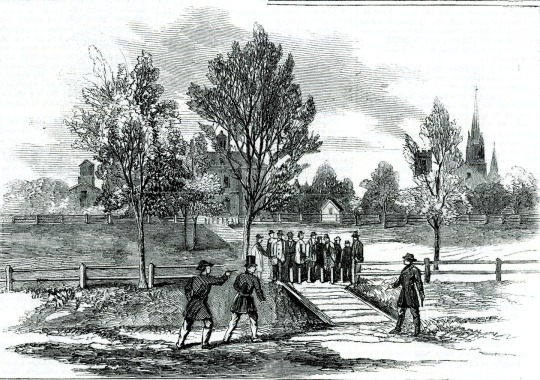
Captives, including students from St. Albans Academy, under guard by Confederate raiders. FROM THE VERMONT HISTORICAL SOCIETY
ON OCTOBER 10, 1864, Bennett Young stepped off the train from Canada, and into the train depot at St. Albans, Vermont, 15 miles south of the border. Young, a handsome, clean-shaven 21-year-old divinity student, took a room at the Tremont House on Main Street and spent the next few days familiarizing himself with the town. But Young was not what he seemed. He was a native of Kentucky, not Canada, and a Confederate officer recently escaped from a prisoner-of-war camp. He was here in this bustling railroad center of about 4,000 residents to change the course of the war.
It had been fewer than five days since Young received a message from C.C. Clay Jr., a former US senator from Alabama. Clay, sent to Canada in 1864 by Confederate President Jefferson Davis to build a network of secret agents, had written: “Your suggestion for a raid upon the most accessible towns in Vermont, commencing with St. Albans, is approved, and you are authorized and required to act in conformity with that suggestion.”
Davis himself had approved the bold series of raids. The South was clearly losing the Civil War. Atlanta had fallen to General William T. Sherman a month earlier. General Ulysses S. Grant’s forces were hounding Robert E. Lee’s Army of Virginia. The port of Mobile, Alabama, had been blockaded by Rear Admiral David Farragut. The hope was that several dramatic raids from Canada into the North would at the least force Union troops north to defend the border, easing pressure on Lee. If Union troops chased the raiders into Canada, it might help draw neutral Canada and Great Britain into the war on the side of the Confederates. And if things went really well, it might demoralize Northern voters so much that they would elect a Democrat as president instead of the Republican incumbent, Abraham Lincoln. Plus, the Confederacy needed cash.
Over the next nine days, some 20 more men from Canada arrived in groups of twos and threes. Like Young, they were also Confederate soldiers posing as Canadian civilians in St. Albans for business or relaxation. These men, only two of whom were older than 30, made polite inquiries about horses they could rent and guns they could borrow for a bit of hunting. Some took day trips to nearby towns, to play out the ruse and scout other targets to raid. Others wandered into the town’s banks, striking up conversations with the locals or inquiring about the price of gold. Their real interest was determining how many employees each bank had. Some occasionally met with Young clandestinely at his hotel, to share information and discuss the outlines of their mission.
Young, meanwhile, played his part with flair. He courted a woman staying at his hotel, impressed the villagers with his conspicuous Bible reading, and visited the home of the governor of Vermont, railroad magnate J. Gregory Smith. Smith was in Montpelier at the time, so his wife, Ann Eliza Smith, showed Young around the grounds. She thought Young “a nice mannered man,” not realizing he intended to burn the mansion down as retribution for the burning of Southern governors’ mansions.
Young had determined two potential escape routes for the bold plan, which would turn out to be the northernmost action of the Civil War. But he also saw a threat: Just a couple of blocks west of Main Street was a busy railway station and foundry, employing dozens of men who might leap into action. Still, he was confident — the raiders were going to need 30 minutes, at most, to rob several banks, torch the town with bottles of an incendiary liquid called Greek fire, and run. In the commotion, Young hoped to also set fire to the governor’s mansion, then raid Swanton, another town, on the way back to Canada.
He fixed Wednesday, October 19, as the day of the attack.
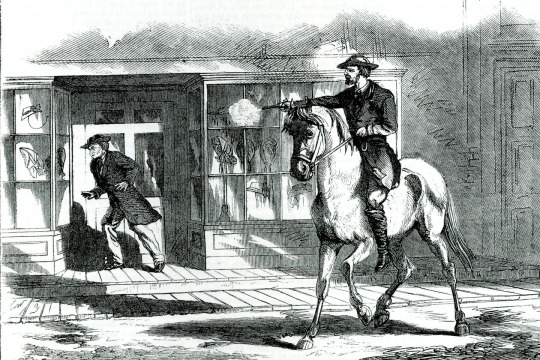
A Confederate raider shoots at E.J. Morrison outside Miss Beattie’s Millinery on Main Street in St. Albans.FROM THE VERMONT HISTORICAL SOCIETY
AT 3 P.M. ON THE 19th, St. Albans’ church bells rang to mark the hour. Under leaden skies that threatened rain, Young strolled down Main Street, then climbed a couple of steps onto a hotel porch. Reaching inside his coat, he pulled out his Navy Colt revolver and raised it over his head. “I’m an officer of the Confederate Service,” he shouted. “I am going to take this town and shoot the first person that resists!”
At first, St. Albans residents within earshot thought Young was joking. They stared at him until he pointed his gun at them and other raiders herded them onto the village green. Other Confederates went to get horses, and three groups of them headed to the town’s banks: Franklin County Bank on Main Street, St. Albans Bank at the corner of Main and Kingman, and the First National Bank on Fairfield. They were barely more than a block apart, all near the town common.
Young climbed on a horse and trotted up and down Main Street, overseeing the roundup of prisoners and monitoring his men’s assault on the banks. He knew his two revolvers had only six shots each, and would be difficult to reload while on horseback. So whenever he saw someone emerge from a building, he’d point his gun at them and tell them to get back inside, intimidating them before they made trouble.
Collins Huntington, though, on his way to pick up his children from school, ignored Young’s threats, thinking he was drunk. Young leveled his revolver and shot at him, inflicting a glancing wound along Huntington’s rib cage.
Inside the Franklin County Bank, a cashier saw a neatly dressed man named William Hutchinson approach the counter. Assuming Hutchinson was a customer, the cashier, Marcus Beardsley, asked how he could help. Hutchinson pulled a revolver from his coat. “We are Confederate soldiers,” he said. “We have come to rob your banks and burn your town. There are a hundred of us here. You must keep quiet and hand over all your money.”
A customer nearby made a run for the door but stopped when the raiders threatened to shoot. Two raiders pushed him into the vault, then began filling their haversacks with bills. Hutchinson, meanwhile, told Beardsley to give him the money from the counter, then locked Beardsley in the vault, too. The four raiders left the bank with approximately $70,000, the equivalent of about $1.2 million today.
Down the street in the St. Albans Bank, Cyrus Bishop stood, terrified, as raiders on either side of him pointed revolvers at his head. “If you make any resistance or give any further alarm, we’ll blow your brains out,” one told him. One of the raiders pointed his pistol at an assistant cashier and told him, “Not a word out of you. We are Confederate soldiers, we have come to take your town, we shall have your money.”
Then the raiders took the time to do something unexpected: They made Bishop and the assistant cashier swear allegiance to the Confederate States of America. While three more raiders entered the bank and stuffed as much money as they could fit in their pockets and satchels, one of the Confederates guarding the two bank employees lectured them on the destruction of the South by Generals Sheridan and Sherman.
The cashier was having none of it. He said if the robbery was an act of war, he should be allowed to take an inventory so that the bank could be reimbursed by the federal government. “Damn your government, hold up your hands,” hissed the raider.
At that point, someone knocked on the bank’s front door, which the rebels had locked behind them. One of the raiders opened it. In walked Samuel Breck, a merchant looking to make a deposit. A rebel grabbed him by the collar with one hand, pressed a revolver to his head with the other, and said, “I take deposits.” He took $393 from Breck and shoved him in the room with the two bank employees.
Suddenly, the sounds of gunfire erupted outside the bank, and three of the raiders ran out. The last two raiders left the bank more slowly, walking backward with their guns raised. They had been in St. Albans Bank for 12 minutes.

Inside the St. Albans Bank, a clerk is threatened at gunpoint by a group of Confederate raiders. FROM THE VERMONT HISTORICAL SOCIETY
YOUNG DIDN’T KNOW where the shots were coming from. There was at least one St. Albans local, possibly more, firing at his raiders from buildings on Main Street. No one had been hit, but Young hadn’t planned for armed resistance.
He had already fired his revolvers three times — at Collins Huntington; at stable owner Sylvester Field, who’d objected to the theft of his horses (the ball passed through Field’s hat); and at Leonard Bingham, a local who had tried to charge him when Young was climbing onto a horse. Young had hit Bingham, but the ball had been stopped by Bingham’s heavy silver watch, and Bingham had escaped. Young had only nine bullets left, but he was going to have to do something to regain control of a situation that was spiraling out of control.
Leonard Cross heard the commotion and stepped out of his photography studio. “What are you trying to celebrate here?” he asked Young.
“I’ll let you know,” Young said, and shot at Cross, barely missing his head. Eight bullets left.
It was time, he thought, to start setting the town on fire. His raiders began throwing their bottles of Greek fire at buildings.
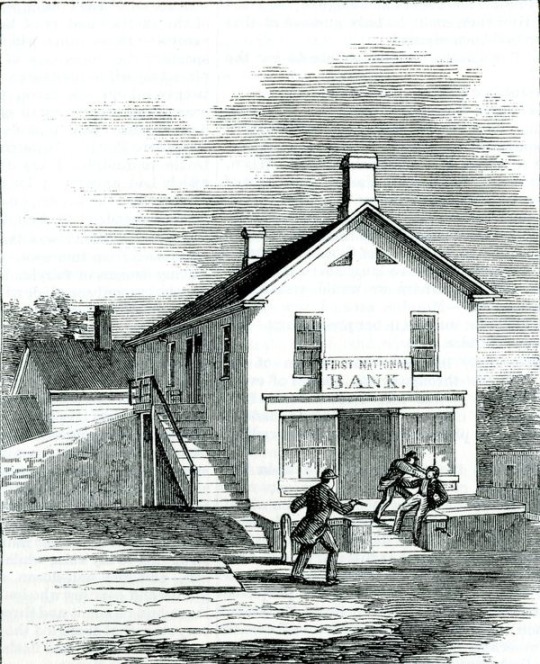
An old editorial illustration depicts William H. Blaisdell of St. Albans accost a raider outside of the First National Bank as another Confederate raced toward them. Blaisdell, like others that day, was taken at gunpoint into what today is Taylor Park. The First National sat at the southeast corner of Main and Fairfield streets, across the street from what is now Taylor Park. CREDIT: VERMONT HISTORICAL SOCIETY (these images originally appeared in Frank Leslie's magazine)
Over at the First National Bank, the third group of robbers had gathered $58,000 (nearly $1 million in current dollars). The four of them left the bank, escorting an employee toward the common, where they were going to put him with the other captives. As they were leaving, they saw a local business owner, William Blaisdell, approaching the bank. Blaisdell quickly realized what was happening and grabbed a raider, throwing him down onto the boardwalk. But other raiders pointed their pistols at Blaisdell’s head, forcing him to surrender.
Buildings should have been burning by now, Young must have realized. But they weren’t — the bottles of Greek fire had hit their targets, but they merely smoldered. Nothing was burning.
More townspeople had realized St. Albans was under attack. Nearby, at the governor’s residence, a neighbor’s servant girl rushed in to tell Vermont’s first lady, Ann Smith: “The rebels are in town, robbing the banks, burning the houses and killing the people,” the girl exclaimed. “They are on their way up the hill, intending to burn your house.”
Smith and a Scottish servant girl sprung into action, calmly closing the blinds and shades of the house and bolting the doors. Then, Smith found one of her husband’s pistols. It wasn’t loaded, but she hoped the raiders wouldn’t realize that. She carried the gun to the front steps, to stand and wait. She wished she had raised an American flag, so if they went down it would be with colors flying.
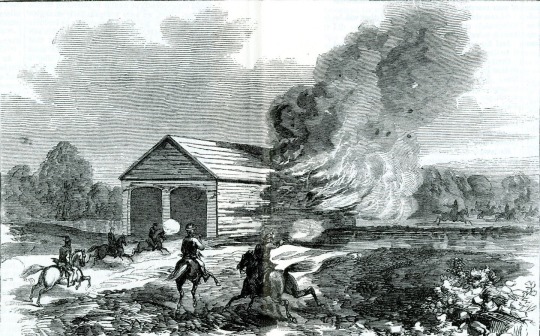
The Confederate raiders set fire to the bridge over Sheldon Creek, but it did not fully burn. FROM THE VERMONT HISTORICAL SOCIETY
BACK IN THE CENTER of town, Erasmus Fuller, a livery owner, grabbed an old six-shooter, pointed it at one of the raiders, and pulled the trigger. Click. Young burst out laughing. “Fetch me some spurs!” he yelled.
Fuller had other ideas. He ducked into Bedard’s Harness Shop and ran to the back door. He started shouting that the town was being attacked, hoping the men who were building a large hotel nearby would come and help him. E.J. Morrison, a Manchester, New Hampshire, man overseeing the hotel’s construction, heard Fuller’s shouts and ran to the stable owner.
Fuller, with Morrison now trailing behind, returned to Main Street. He saw Young, lifted his pistol again, and took aim.
“Look out Cap’n!” shouted one of the raiders. Then he and Young both fired at Fuller. Fuller ducked behind an elm tree, evading their shots.
Not so Morrison, who dropped to the ground, mortally wounded. He would be the raid’s sole fatality, leaving behind a widow and five children. (What the raiders didn’t know is that he was also likely the only man in town sympathetic to the Confederate cause.)
George Conger had heard the gunshots and come running. Young saw him, and asked, “Are you a soldier?”
“I am,” Conger replied. He had been a captain in the Union Army and had been wounded at the Second Battle of Bull Run.
“Then you are my prisoner,” Young said. But Conger dashed into the American House hotel, next to the Franklin County Bank, ran through the back and then down Lake Street toward the foundry, yelling, “There is a regular raid on St. Albans. Bring out your guns and fight!” Workers at the foundry and at the railroad grabbed weapons and followed Conger back to the center of town.
Young realized his plot was quickly unraveling. He began to move his men north, shouting, “Keep cool boys, keep cool!”

An old editorial illustration depicts cashier Marcas W. Beardsley and Jackson Clark, a woodsawyer who happened to be in the Franklin County Bank, being freed from the vault where they had been imprisoned, even though Beardsley had pleaded with the robbers explaining it was airtight. The men, who understood the Confederates planned to burn the town, feared for their lives either by suffocation or fire. J. Russell Armington and Dana R. Bailey heard their shouts and came to their rescue, however. CREDIT: VERMONT HISTORICAL SOCIETY (these images originally appeared in Frank Leslie's magazine)
Conger, gun in hand, tried to shoot at the raiders, but his gun would not fire. The Confederates started firing on him and yelling the rebel yell, but this riled up their horses, which were not used to battle. Over the din, Young was hollering, “There is too great a crowd gathering round here!” He knew they had to get out of town, and quickly.
Spurring his horse around those of his men, he told them to throw their remaining bottles of Greek fire at the closest buildings. Again, they failed to ignite. It was time to go. Once Young was sure his men were all accounted for, they were off at a gallop, occasionally turning to fire pistols behind them.
Conger shouted to all those nearby, “Bring on your horses, men, and arms and we will follow them. If you can’t get arms there is no use, they are going to fight hard!”
On the steps of the governor’s residence, Ann Smith saw a man galloping to her. The hour has come, she thought, the invaders have arrived. But the man on horseback turned out to be her brother-in-law, Stewart Stranahan, who was home on sick leave from the Army of the Potomac. Stranahan told her the raiders had robbed the banks and killed a man, but failed to set St. Albans ablaze. He had come for any weapons he could scrounge.
“Here, take this pistol, it is all I have yet found,” Smith said, feeling rage build inside her. “And, Stewart,” she added, “if you come up with them, kill them! Kill them!”
Soon, Conger and a posse of some 50 men were in pursuit of the raiders, followed quickly by 40 more men led by Stranahan. The Confederate party split up before it reached Canada, to increase the odds of escape. Conger’s militia reached the border and kept going, joining with some Canadian constables. They were able to capture about 13 raiders, including Young, and some of the $208,000 ($3.5 million in today’s money) that was later determined missing.
THE PLAN OF THE St. Albans group was to bring their prisoners back to town to face charges of murder. But as they neared the border, more Canadian authorities arrived at the scene and demanded charge of the rebels. Conger reluctantly agreed. The prisoners were first brought to St. Johns and then transferred to Montreal on October 27. The raiders were well received by a contingent of Canadian Confederate sympathizers, cheered as they were brought to jail.
They gave Young and his men food, clothing, and even liquor. Some of Montreal’s finer restaurants sent over meals and scores of citizens visited them at the jail, where they had been given a large room rather than cells. A relaxed Young wrote to the St. Albans Messenger requesting two copies of the paper be delivered each day. “Your editorials are quite interesting and will furnish considerable amusement to myself and comrades,” he wrote.
Young’s taunting infuriated many Vermonters, and for a short period of time it appeared that the Confederates might succeed in dragging Canada into the war against the Union. The St. Albans Messenger editorial page stated that if the prisoners were not handed over, “The sooner we declare war on our neighbors to the north, the better.” Lincoln’s secretary of war, Edwin Stanton, later called the St. Albans Raid “one of the most important events of the war,” with the potential to draw both Canada and Britain into hostilities.
But over the next few months, a series of contentious court proceedings went against extradition, as Canadian judges ruled that the raid was an act of war, not murder and robbery. All the raiders were eventually freed.
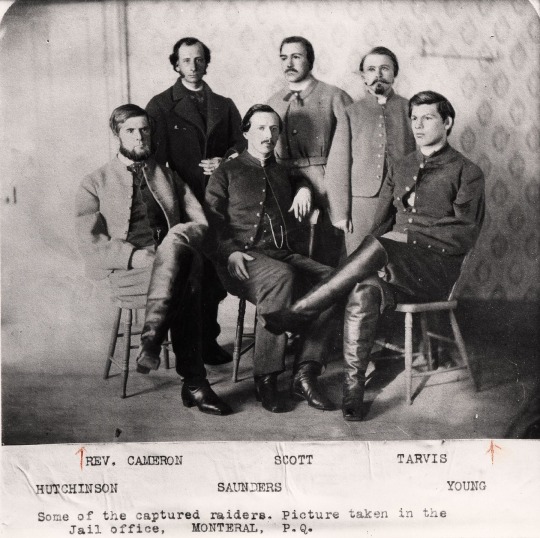
Some of the Confederates in jail in Montreal. Bennett Young is seated at right, William Hutchinson is at left. FROM THE VERMONT HISTORICAL SOCIETY
But Bennett Young’s gambit had failed. Perhaps if the Greek fire had worked and more damage had been done, it would have enraged Vermonters more. Or if there had been follow-up raids on Swanton or other towns. But the St. Albans citizens had forced them to abandon those plans. No Union troops were diverted to the border, Canada and Great Britain did not enter the war, Lincoln was reelected, Sherman reached the sea in late December 1864, and on April 9, 1865, Lee surrendered at Appomattox Court House. The Canadian government even reimbursed the Vermont banks for the amount of money it found on the raiders, approximately $88,000. The other $120,000 was not accounted for.
After the war, Young was specifically excluded from an amnesty for Confederates. He fled to the United Kingdom, where he studied law. He returned to the United States after a full amnesty was granted in1868, becoming a successful lawyer in Louisville, Kentucky, and was regularly applauded at Confederate reunions and parades.
In 1911, when he was 68, Young took his wife on vacation to Montreal. He contacted the people of St. Albans, saying he would like to meet with them. The town sent a four-man delegation to the Ritz-Carlton, where he was staying. Young put on a Confederate uniform for the session, and told his visitors that “the raid was only the reckless escapade of a flaming youth of 21 years, steeped in patriotism for the South.” Perhaps it was something like an apology. The get-together was friendly and lasted well into the night.
— Michael Tougias is the author of more than 30 books for adults, most recently “The Waters Between Us,” and five for middle readers. He is currently working on a book about the St. Albans Raid. Send comments to [email protected]. In addition to reporting and eyewitness accounts from the St. Albans Messenger and other periodicals, significant sources for this story include materials from the St. Albans Historical Society and The St. Albans Raid, Complete and Authentic Report by L.N. Benjamin.
1 note
·
View note
Text
Update to the list of arthurian books, now there are 668 books
I finally updated the whole list of arthurian books! While I am pretty confident of part 1, part 2 and part 3, the new part 4 is... a tentative list, because nowadays everyone can publish anything.
THE ENTIRE LIST IS HERE
PART 4 (the new one) is now here
the rest of the update is under the cut
1954 - Half Magic (Edward Eager) [gr]
1967 - Page Boy of Camelot (Eugenia Stone) [gr]
1976 - A World Called Camelot (Arthur H. Landis) [gr]
1979 - Gawain and the Green Knight: Adventure at Camelot (Y. R. Ponsor) [gr]
1981 - Three Romances: Love Stories from Camelot Retold (Winifred Rosen) [gr]
1982 - Bride of the Spear (Kathleen Herbert) [gr]
1995 - The Sword of Camelot (Gilbert L. Morris) [gr]
1998 - Fang the Gnome (Michael G. Coney) [gr]
1998 - [1-4] Macsen's Treasure (Kathleen Cunningham Guler) [gr]
1998 - Quest for Camelot: Digest Novelization (Gardner, Vera Chapman) [gr]
1999 - The Lovers: The Legend of Trystan and Yseult (Kate Hawks) [gr]
1999 - [1-5] Merlin's Descendants (Irene Radford) [gr]
2007 - [1-10] Sir Gadabout (Martyn Beardsley) [gr]
2008 - Arthur and Guen: An Original Tale of Young Camelot (Koons, Igor Oleynikov) [gr]
2009 - [P] The Quest of Merlin (Richard Hovey) [gr]
2009 - Carnal Camelot (Anny Cook) [gr]
2009 - [AU] Two Knights in Camelot (Charlene Teglia) [gr]
2010 - [P] The Marriage of Guinevere (Richard Hovey) [gr]
2010 - [1-2] [AU] Shades series (Carol Oates) [gr]
2011 - [AU] King Arthur and the Dragon of Camelot (Frances Collier-Iovell) [gr]
2011 - [AU] A Hard Day's Knight (Simon R. Green) [gr]
2011 - Vampires of Camelot (Joanne Padgett) [gr]
2011 - Romance at Camelot (Mervyn Whittaker) [gr]
2011 - The Other Side Of The Mist (Kristi Lavery) [gr]
2012 - [1-5] Camelot Prophecies Series (Lady Antiva) [gr]
2012 - Arturius - A Quest For Camelot (David F. Carroll) [gr]
2012 - Shard of Galahad: The Camelot Prophecies (Lady Antiva) [gr]
2012 - Full Moon Over Camelot (Edward G. Talbot) [gr]
2013 - [1-3] New Camelot Series (Torie N. James) [gr]
2013 - The Crownless King (Phil Williams) [gr]
2013 - A Visit to the Kingdom of Camelot (R. L. Greenwood) [gr]
2013 - The Fearless Coward (Phil Williams) [gr]
2013 - Erotic Nights of Camelot (Lana Swallows) [gr]
2013 - Christmas in Camelot (Brenda Jernigan) [gr]
2013 - Mordred (Justine Niogret) [gr]
2013 - Countdown to Camelot (Bruce S. Hart III) [gr]
2013 - The Shadow of Camelot (Wendy Leighton-Porter) [gr]
2013 - The Werewolf of Camelot (Peter Joseph Swanson) [gr]
2014 - [1-3] [AU] Forever Camelot (J. Lynn McCoy) [gr]
2014 - Camelot Shadow (Sean Gibson) [gr]
2014 - The Prince of Camelot (Napoli St. Croix) [gr]
2014 - [AU] The Keepers of Camelot (Cheryl Pierson) [gr]
2014 - [AU] Time and Again: The Round Table Reincarnated (Jeremy Hone, Aadland) [gr]
2014 - [AU] The Quest for Camelot (Angela Schroeder) [gr]
2014 - [1-4] Legendary Saga (L. H. Nicole) [gr]
2014 - [1-3] [AU] Albion's Circle (Jessica Jarman) [gr]
2014 - The Robed Pretender of Mordred Castle (Fred La Lone) [gr]
2015 - Camelot's Enchantress Book One: The Blacksmith (Alexandria St. Claire) [gr]
2015 - Murder Comes to Camelot (Tim Ellis) [gr]
2015 - [AU] Blind Devotion: The curse of Camelot (McKendrick) [gr]
2015 - King Arthur - A Pantomime Adventure in Camelot (Paul Reakes) [gr]
2016 - Finding Camelot (Arthur - The Story of a King, #1) (C. G. Rucker) [gr]
2016 - [1-5] [AU] New Camelot (Sierra Simone) [gr]
2016 - [1-4] Britannia Series (Ana Alonso, Pelegrin) [gr]
2016 - [1-2] Camelot Returns (Heather Cimino) [gr]
2016 - Morgawse (Lavinia Collins) [gr]
2016 - The Once and Future Camelot (Felicity Pulman) [gr]
2016 - [AU] Once Upon a Time in Camelot (James Patrick Hunt) [gr]
60 notes
·
View notes
Text
I was tagged by the very lovely @theiceandbones to post my 2021 reading plans
Thank you <3
O.K. Right away I have to cheat slightly it’s not a 2021 reading list … it‘s just a general list … if I don‘t make it this year that is fine … books don‘t run away XD
Like every year, two books I have borrowed, “The Name of the Wind” and “The Wise Man's Fea” by Patrick Rothfuss
Though … I‘m in no particular hurry since they are borrowed from someone who ghosted me … so … I think that means they now are mine?
Cool, free books XD
Plus, I don‘t really want to read to doorstopper sized novels wen the third part isn‘t even written yet …
SO … I fear they will end up on net years list again XD
What else? Diverse Discworld books, again, I am in no hurry … seeing as there never will be any new ones :-( and I am already down to three …
The Last Continent
Monstrous Regiment
MakingMoney
What else … some Franklin stuff
“Deadly Winter” by Martyn Beardsley
„Unravelling the Franklin Mytery“ and „Strangers among us“ by David C. Woodman
The last chapter of: “James Fitzjames: The Mystery Man of the Franklin Expedition” by William Battersby
So far I never could get myself to read past spring 1845 …
And in case I can get my grubby little fingers on a pdf of it … or if the Pandemic finally is beaten and I can justify to myself going to a Library to read it there: CYRIAX, Richard J. (1885-1967). Sir John Franklin’s Last Arctic Expedition: a Chapter in the History of the Royal Navy. London: Methuen & Co. Ltd., 1939.
And of course the giant folder on my desk that says: Franklin Stuff – yet to be read XD
I suck at tagging people who actually want to be tagged so … everyone is invited <3
3 notes
·
View notes
Text
Chapter 11 & 12
I had to take a little break from posting because I suffered a loss in the family (a really close family member).
Reading chapter 11, I began to see how the different forms of Art Nouveau. The period of the Art Nouveau movement flourished between 1890 and 1910. The different forms of Art Nouveau and the reasons they differ depends on the country. In the Asian countries the ukiyo-e became a prominent form of Art Nouveau. Art Nouveau made it to Paris; Jules Cheret and Eugene Grasset are listed as importation in this transition. The Art Nouveau movement made it to England primarily with the use of graphic design and illustration. Art Nouveau also made it to America by way of British and French graphic art. There were two forms of Art Nouveau that existed in the Netherlands called Nieuwe Kunst and Batikt. Nieuwe Kunst spanned from 1892 to 1906 and is described as more playful and diverse. Germany also had a form of Art Nouveau called Jugendstil.
Chapter 12 details the design in the turn of the century. In this chapter, readers are introduced to the Vienna Secession style of design. This style is the style that bridged the 19th century with the 20th century. Areas of change in the 20th century include designs for architecture, graphic, & typography. The text show that the worlds first underground electric rail system opened in London. This railway system was instrumental in visual design by being an area of free publicity to people that used the public transportation system.
**Notes**
It appears as though women was inspiration to many artist that contributed to the Art Nouveau. Western societies became engulfed with all things Japanese. The term for this mania is Japonsime. The spread of Art Nouveau became possible through advances in transportation and communication.
**People & Entities**
Hishikawa Moronobu: is the first master of the ukiyo-e print.
Kitagawa Utamaro: is called the supreme poet of Japanese Print. He specialized in the portraying nature and human expression such as insects, bird, flowers, and women of great beauty. He went to jail for his pettiness because he depicted military ruler Toyotomi Hideyoshi wife and concubines. hahhahaha so far he’s my fave of chapter 9.
Jules Cheret: Jules has many accomplishments. The reason for his mention here is because I think it is amazing that he completed his work directly on lithographic stones. He was also a man in support of feminism. He did this with his work by showing a new role for women. According to the text, these women are self assured, happy, wearing low cut dresses, dancing, drinking wine, and publicly smoking. He was named the Father of Women Liberation.
Eugene Grasset: Was inspired by medieval art and Asian art. He developed what is called the coloring book style of art. Grasset is also very important in spread of Art Nouveau in America.
Aubrey Beardsley: Contribution includes work using a vibrant black and white art. This black and white art was coined “The Black Spot”. He continued his work despite being hated on by William Morris. He later was named Art Editor for the Yellow Book magazine.
Alphonse Mucha :is a very important person in the wide spread of Art Nouveau. He created art with women as the focus surrounded by stylized forms of plants and flowers. The women that is portrayed in Mucha’s work are what I call every kind of woman (basically a woman figure without specifics except European.)
Van de Velde: was an architect, painter, designer, and educator. His talents and accomplishments collectively established prominence to be mentioned in the text. Van de Velde used the human imagination to drive the points of his work. This is because he used abstract expression in his work. Instead of telling about the product or showing someone using the product, he would use abstract expressions to deliver messages to viewers. There is a quote from the text that stood out to me from Van de Velde that influenced the development of 20th century architecture and design theory: “He taught that all branches of art-from painting to graphic design, from industrial design to sculpture--share a common language of form and are of equal importance to the human community.”
Glasgow school: consisted of a group of four designers: J Herbert McNair, Charles Rennie Mackintosh, and Margaret and Frances Mcdonald. The group collaborated on a number of designs , one of my favorites is the poster for Glasgow school. Though the four are all designers, they all have specialty areas in design such as Mackintosh specializing in the design of objects, chairs, and interiors.
The Kunstlerhaus, the Viennese Creative Artist Association: The group consisted of Painter Gustav Klimt, architects Joseph Maria Olbrich and Josef Hoffman, and artist-designer Koloman Moser.
Ver Sacrum: is a magazine that displayed many designs by various artist. This is the magazine that businesses, writers, and artist alike wanted to be in.
Peter Behrens: was an artist, architect, and designer that sought typographic reform. He is also known as “the first industrial designer”. According to the text Behren believed that after architecture, typography provided “the most characteristic picture of a period, and the strongest testimonial of the spiritual progress and development of a people. (this last quote sums up the evolution of the alphabet and writing. I including this from the text because it sums up the first few chapters in a quote). Some of the designs Behren was responsible for designing include teakettles, fans, street-lamps, and industrial products.
Edward Johnston: is a calligrapher and teacher that designed a version of the Railway system in London that was established in 1890. His version of the stations signage and logo are still in use today.
Designs:
Salon Des Cent: I love the contrasting colors. The warm colors on the woman pop out more against the cool colors in the background. I also love the use of thick bold lines.
Tournee du Chat Noir dr Rodolphe Salis: I love this design. The use of warm colors allows this poster to stand out. The cat covers most of the left side of the poster extending from the top and the bottom of the poster.
General Electric trademark: I had to include this design mostly because of familiarity and the fact that I now understand why it was designed the way it is. I now know the styling of the design.
Poster for the Glasgow Institute of the Fine Arts: the design of this poster is beautiful. It gives a sense of direction by allowing white space to exist surrounding the figure. The figure is in a red color which grabs the viewer attention and the image is balanced. I think I love it because it seems as though the figure is becoming or is in touch with his/her higher self.
Poster for the thirteenth Vienna Secession exhibition: this poster is clearly inspired by the Poster for the Glasgow Institute of the Fine Arts. I love the use of the cool colors as accent colors in the warm colors and the fact that there are three figures. It creates a triangular illusion with the use of the three figures in the middle of the circle.
Poster for Fledermaus: This design was created by Berthold Loffler. Loffler did a great job with this. The use of colors pop on a black background, the warm colors red and yellow are attention grabbers, and the white mask is contrasting with the black background for its attention grabbing power.
Muthesius: believed in simplicity and exactness with the use of machinery. He wanted to elimiate all ornaments. I mentioned him because I wholeheartedly agree even though I also agree with Van de Veldes vision of expression.
AEG Electric Lamp Poster: The geometric elements in this poster makes this design stunning. The light bulbs is centered at the top of the triangle and appears to be emitting light in the form of small circles that are contained by the triangle as if it is a lamp shade. The light is flowing in the direction towards the text of the poster, driving the viewers attention to the name of the product. Brilliant!
**Religion** (You know I have to include that religion portion because the book tells it in the nicest way.)
Quoting from the text: Fearful of the potential impact of European colonial expansion and Christian Missionaries (take overs; Massacres) on Japanese culture, the shogun issued three decrees in the 1630′s excluding foreigners and adopted an official policy of national seclusion.
The above fears of the Asian people came to fruition. The text speaks of the Asian artifacts that were taken and place as trophies in museums.
2 notes
·
View notes
Text
Art Inspiration- Art Nouveau Art Nouveau, ornamental style of art that flourished between about 1890 and 1910 throughout Europe and the United States. Art Nouveau is characterised by its use of a long, sinuous, organic line and was employed most often in architecture, interior design, jewellery and glass design, posters, and illustration. It was deliberate attempt to create a new style, free of the imitative historicism that dominated much of the 19th- century art and design. About this time the term Art Nouveau was coined, in Belgium by the periodical L’Art Moderne to describe the work of the artist group Les Vingt and in Paris by S. Bling, who named his gallery L’Art Nouveau. The style was Called Jugendstil in Germany, Sezessionstil in Austria, Stile Floreale or ( Stile Liberty) in Italy, and Modernismo

In England the style’s immediate precursors were the Aestheticism of the illustrator Aubrey Beardsley, who depended heavily on the expressive quality of organic line, the Arts and Crafts movement of Williams Morris, Who established the importance of a vital style in the applied arts.
On the European continent, Art Nouveau was influenced by experiments with expressive line by the painters Paul Gauguin and Henri de Toulouse-Lautrec. The movement was also partly inspired by a vogue for the linear patterns of Japanese prints (ukiyo-e)

To distinguishing ornamental characteristic of Art Nouveau is its undulating asymmetrical line, often taking the form of flower stalks and buds, vine tendrils, insect wings, and other delicate and sinuous natural objects; the line may be elegant and graceful or infused with a powerfully rhythmic and whiplike force. In the graphic arts the line subordinates all other pictorial elements- form, texture, space, and colour-to its own decorative effect.
In architecture and the other plastic arts, the whole of the three-dimensional form becomes engulfed in the organic, linear rhythm, creating a fusion between structure and ornament.
Architecture particularly shows this synopsis of ornament and structure; a liberal combination of materials - ironwork, glass, ceramic, and brickwork- was employed for example, in the creation of unified interiors in which columns and beams became thick vines with spreading tendrils and windows became both openings for light and air membranous outgrowths of the organic whole. This approach was directly opposed to the traditional architectural values of reason and clarity of structure.

There were a great number of artists and designers who worked in the Art Nouveau style.
Some of the more prominent were the Scottish architect and designer Charles Rennie Mackintosh, who specialised in a predominantly geometric line and particularly influenced the Austrian Sezessionstil ; the Belgian architects Henry van de Velde and Victor Horta, whose extremely sinuous and delicate structures influenced the French architect Hector Guimard, another important figure; the American glassmaker Louis Comfort Tiffany; the French furniture and ironwork designer Louis Majorelle; the Czechoslovakian graphic designer-artist Alphonse Mucha; the French glass and jewellery designer Rene Lalique; the American architect Louis Henry Sullivan, who used plantlike Art Nouveau ironwork to decorate his traditionally structured buildings; and the Spanish architect and sculptor Antionio Gaudi, perhaps the most original artist of the movement, who went beyond dependence on line to transform buildings into curving, bulbous, brightly, coloured, organic constructions.

After 1910 Art Nouveau appeared old-fashioned and limited and was generally abandoned as a distinct decorative style. In the 1960s, however the style was rehabilitated in part, by major exhibitions organised at the Museum of Modern Art in New York (1959) and at the Musee National d’art Modern Art in New York (1959) and at the Musee National d’Art Moderne ( 1960) as well as by a large-scale retrospective on Beardsley held at the Victoria and Albert Museum in London in 1966. The exhibitions elevated the status of the movement, which had often. been viewed by critics as a passing trend, to the level of other major Modern art movements of the late 19th century.Currents of the movement were then revitalised in Pop and Op art.
In the popular opinion, the flowery organic lines of Art Nouveau were revived as a new psychedelic style in fashion and in the typography used on rock and pop album covers in commercial advertising.
4 notes
·
View notes
Text
Disks Wear Art on Their Sleeves to Woo Buyers
Richard F. Shepard, The New York Times, 12 March 1968
There, in riotous profusion, are the album art covers that employ graphics, sculpture, lithography, etchings, paintings, abstruse photography and combinations of all to grab the customer's eye and reach into his pocket. The stodgy photo of a Beethoven bust that once gave “class” to an album has given way to mad splashes of color and irreverent illustration designed to attract the young buyer.
There is no single school of album art. It draws from baroque stylings, art nouveau of the fin de siècle, San Francisco posters and the Inspiration of performers themselves who are spending more time than ever on their covers, often to the despair of record companies interested more in sales pull than in ego.
The album art “revolution,” in the making for several years, has provided classical and pop records with a visual veneer of sophistication, simplicity, wit and creativity that brooks no distinction between Rachmaninoff and Ringo. But so quickly do styles change that some in the trade.already see the,waning of the “psychedelic” art of last season's covers, although its lurid colorations, multiple exposures and fuzzy movement are still a powerful influence.
Powerful Vibrations
The expanding emphasis on the look of record covers has been inspired by the sound inside the new thumping rhythms of electrically generated pop that has been dominating music to an extent that hot jazz, swing and bebop never did. It is a style of music for a type of generation that demands action and innovation in what it sees and hears. The static art of romantic mood is out. The trend to the new look has influenced classical albums sold to youthful customers who also buy pop and it has eyert affected the “middle of the road” music that appeals to the older, more sedentary crowd.
In the rush for uncommon attraction on the outside as well as in the grooves, cover art flows in all directions.
For example, the Beatles commissioned, through their own designer in England, the hydra-headed cover of Sergeant Pepper's Lonely Hearts Club Band, issued here by Capitol Records. It shows the famous four at a burial plot against a background of dozens of heads, photographs and drawings (there’s even an album credit for wax figures of the old Beatles by Madame Tiissaud).
Among those who show up in the crowd are Fred Astaire, Clarence Darrow, Marilyn Monroe, Laurel and Hardy, Edgar Allan Poe, W. C. Fields, Karl Marx, Marlon Brando, H. G. Wells and Sigmund Freud.
An RCA Victor cover for a Boston Symphony recording of a Brahms work has a piece of classical Greek statuary painted over with strikingly colorful abstract art.
Home Movies
Leonard Cohen, the folk singer, insisted on taking his own picture for a Columbia album. He went to an amusement arcade, spent a quarter in the automatic photo machine, and brought the result back as the cover picture. Bob Dylan, in search of simplicity, chose his latest album cover from an assortment of black-and-white snapshots.
Ironically, Columbia is blazing a new trail that could influence the entire design industry. The latest record of the United States of America, a rock group, went on sale last week with the disk enclosed in a plain manila envelope, identified by the rubber-stamped name of the band on the outside.
Although psychedelic art is still a major influence, Victorian and old English typefaces are appearing more frequently on pop album covers.
“The youngsters were brought up in the Bauhaus form-follows-function tradition,” explained Robert Jones, art director of RCA. “This trend toward the ornate is part of their rebellion.”
Art nouveau, particularly the flowing lines of the Beardsley style, is also showing up more strongly on the rock albums, although this is probably part of the psychedelic scene. But .the photograph is the stock-in-trade of albums that are selling personalities. The difference is that the art does more than depict; it tries to express a whole mood.
“We ran sex into the ground before the personalities took over,” said Mr. Jones, noting that the bosomy girl that decorated mood-music albums went out with the popularity of rock and blues.
Allan Steckler, London’s art director, who sends his opera stars to high-fashion photographer’s for carefully informal portraits, said: “Two nude chicks on a piano won't tell you anything about the Mendelssohn concerto, inside.”
Elektra uses photos on its pop albums, but has taken to irreverent baroque-style cartoons on Its classical Nonesuch label. “Baroque was a bawdy, fun period,” said William S. Harvey, vice president in charge of advertising, promotion and publicity. “When we started this in 1964, we went for the young college student and intellectual. I thought it was wrong to put classical music on a pedestal, with Beethoven busts. Baroque gave us impact.”
Do album covers sell records? Not to the buyer who comes into a store for a particular record; perhaps to the customer who has bought what he wants and is just thumbing through the counters. The cost of making a cover is relatively small, averaging $1,500 at one large company, lower at others and more for albums made by big stars who can turn down covers they don’t like.
“There can be a lot more ego than trade when you work with a big artist,” observed the art man of one small company.
#1968#the beatles#sixties#Leonard cohen#album covers#album art#sgt. pepper's lonely hearts club band#LPs#albums#graphic design#1960s#60s
3 notes
·
View notes
Text
ENG 703 Survey of Literary Criticism & Theory syllabus
Tuesdays 4:00-6:45 pm
Professor Anne H. Stevens, Department of English
This course is designed to introduce graduate students to some of the major texts within the long and complex tradition of literary theory and criticism. In a semester, the task is nearly impossible. The best I can hope to do is to introduce you to a wide range of approaches so that you can explore further on your own. The course is divided into four units of unequal length: 1) Foundations 2) Formalism, structuralism, poststructuralism 3) Race, class, gender, sexuality, and 4) Books, readers, history. Within these units we will be reading a mixture of entire books, journal articles, and extracts from books. Some of these readings you have almost certainly encountered before while others will likely be new to you. I have also ordered from the bookstore but am not requiring my companion book, for students who want a broad historical overview (from antiquity to the present). We will cover some historical context in class but our main focus will be on reading and understanding the primary texts.
Required Texts: (available at the bookstore or elsewhere)
G. W. F. Hegel, Introduction to the Philosophy of History
Karl Marx, The Portable Karl Marx
Roland Barthes, S/Z
Frantz Fanon, Black Skin, White Masks
Michel Foucault, The History of Sexuality, Part 1
Rita Felski, The Limits of Critique
Other readings available through Web Campus or via email for auditors.
Optional Text: Anne H. Stevens, Literary Theory and Criticism: An Introduction
Course requirements for enrolled students: At least three 100-200 word blog posts, three initial responses to another student’s post, and a 2000-4000 word final reflection paper. Active participation in class discussion both in class and online.
Course requirements for auditors and passers-by: All are welcome to sit in on the class; you can choose your own level of engagement. Any auditors or others who wish to are encouraged to post and comment on the course blog and to participate in class discussion. I will make the Web Campus readings available via email for those who are interested.
The course blog: I have set up a WordPress blog for this course at eng703.wordpress.com. I will enable all registered students and auditors access as blog “authors.” This means you will be able to create posts, upload files, and moderate comments on your own posts. You will not be able to delete other people’s posts or the site itself. Each registered student must commit to writing three 100-200 word posts over the course of the semester and three initial responses to someone else’s post (I will pass around a sign-up sheet on the first day). Auditors are encouraged but not required to post and to respond to others’ posts.
Your posts should relate to the week’s reading and should be posted by 5:00pm on the Sunday before class, thus allowing enough time for the respondent to post and for others to comment prior to class. These posts will serve to begin our course discussion each week, and the discussion can continue online after class is over. Your posts can take a range of forms but should not be mere summary of the reading. Instead, they should focus on a particular passage, term, or question; connect the reading to something else either within or outside the class; use examples to clarify a theoretical point; etc. The designated first respondent should engage with the post and continue the conversation while remaining civil. Keep the genre of the blog post in mind as you write: images and links are encouraged, as are pithy provocations; detailed textual analysis is better reserved for classroom discussion.
Reflection paper: At the end of the semester, all registered students must write a 2000-4000 word essay that reflects upon the readings for the course and your own identity as a literary theorist. We’ll talk more as the semester goes on about the kinds of things you should and shouldn’t include in this paper. Your first task is to try to understand the sometimes quite difficult texts we’ll be reading. Your next task is to synthesize the readings, to find points of agreement and disagreement, to understand the range of approaches to a single topic. The first two tasks will constitute our main focus in the class discussion and course blog. Your third task, and the one that will form the substance of this final piece of writing, is to begin to internalize the theoretical approaches you have read, adopting and transforming concepts and methodologies that best suit your identity as a critic.
Schedule:
January 16: first day of class. Introduction, sign up for blog postings.
1 Foundations
January 23: G. W. F. Hegel, Introduction to the Philosophy of History
January 30: Karl Marx, Theses on Feuerbach, from A Contribution to the Critique of Political Economy, and from The German Ideology, pp. 155-83; from The Eighteenth Brumaire of Louis Bonaparte pp. 287-323; from Capital pp. 432-503.
February 6: Sigmund Freud, “Creative Writers and Day-Dreaming”; “Remembering, Repeating, and Working-Through”; “The ‘Uncanny’”; “A Note Upon the ‘Mystic Writing-Pad”
2 Formalism, structuralism, poststructuralism
February 13: Ferdinand de Saussure, from Course in General Linguistics; Friedrich Nietzsche, “On Truth and Lying in a Non-Moral Sense”; Claude Lévi-Strauss, “The Structural Study of Myth”; Tzvetan Todorov, “Some Approaches to Russian Formalism”
February 20: W. K. Wimsatt and Monroe Beardsley, “The Intentional Fallacy”’; W. K. Wimsatt, “The Chicago Critics”; R. S. Crane, introduction to Critics and Criticism; Jacques Derrida, “Structure, Sign, and Play in the Discourse of the Human Sciences”
February 27: Roland Barthes, S/Z
3 Race, class, gender, sexuality
March 6: Simone de Beauvoir, from The Second Sex; Walter Benjamin, “Theses on the Philosophy of History”; Louis Althusser, “Ideology and Ideological State Apparatuses”; Raymond Williams, “Dominant, Emergent, and Residual”
March 13: Frantz Fanon, Black Skin, White Masks
March 20: Michel Foucault, History of Sexuality
April 3: Adrienne Rich, “Compulsory Heterosexuality and Lesbian Existence”; Hélène Cixous, “The Laugh of the Medusa”; Julia Kristeva, “Approaching Abjection”
April 10: Gloria Anzaldúa, from Borderlands/La Frontera; Judith Butler, from Gender Trouble; Eve Kosofsky Sedgwick, from Epistemology of the Closet; bell hooks, from Ain’t I a Woman
4 Books, readers, history
April 17: Stanley Fish, “Interpreting the Variorum”; Hans Robert Jauss, “Literary History as a Challenge to Literary Theory”; Pierre Bourdieu, from Rules of Art; Bruno Latour, “Why Has Critique Run Out of Steam?”
April 24: Clifford Geertz, “Thick Description: Toward an Interpretive Theory of Culture” and “Deep Play: Notes on the Balinese Cockfight”; Hayden White, “The Historical Text as Literary Artifact’; Stephen Greenblatt, from Shakespearean Negotiations; Howard Becker, from Art Worlds
May 1: Rita Felski, The Limits of Critique
Finals week: wrap-up and celebration.
May 11: Final reflection due
2 notes
·
View notes
Photo

Happy Birthday Sgt. Pepper!
1. SRI YUKTESWAR GIRI, 2. ALEISTER CROWLEY, 3. MAE WEST, 4. LENNY BRUCE, 5. KARLHEINZ STOCKHAUSEN, 6. W.C. FIELDS, 7. CARL GUSTAV JUNG, 8. EDGAR ALLEN POE, 9. FRED ASTAIRE, 10. RICHARD MERKIN, 11. THE VARGA GIRL, 12. LEO GORCEY, 13. HUNTZ HALL, 14. SIMON RODIA, 15. BOB DYLAN, 16. AUBREY BEARDSLEY, 17. SIR ROBERT PEEL, 18. ALDOUS HUXLEY, 19. DYLAN THOMAS, 20. TERRY SOUTHERN, 21. DION 22. TONY CURTIS, 23. WALLACE BERMAN, 24. TOMMY HANDLEY, 25. MARILYN MONROE, 26. WILLIAM S. BURROUGHS, 27. SRI MAHAVATAR BABAJI, 28. STAN LAUREL, 29. RICHARD LINDNER, 30. OLIVER HARDY, 31. KARL MARX, 32. H.G. WELLS, 33. SRI PARAMAHANSA YOGANANDA, 34. ANONYMOUS DUMMY, 35. STUART SUTCLIFFE, 36. ANONYMOUS DUMMY, 37. MAX MILLER, 38. THE PETTY GIRL. painting of his wife, Anna Mae Clift, by GEORGE PETTY, 39. MARLON BRANDO, 40. TOM MIX, 41. OSCAR WILDE, 42. TYRONE POWER, 43. LARRY BELL, 44. DR. DAVID LIVINGSTONE, 45. JOHNNY WEISSMULLER, 46. STEPHEN CRANE, 47. ISSY BONN, 48. GEORGE BERNARD SHAW, 49. H.C. WESTERMANN, 50. ALBERT STUBBINS, 51. SRI LAHIRI MAHASAYA, 52. LEWIS CARROLL, 53. T.E. LAWRENCE, 54. SONNY LISTON, 55. THE PETTY GIRL 2, 56. GEORGE HARRISON, 57. JOHN LENNON, 58. SHIRLEY TEMPLE, 59. RINGO STARR, 60. PAUL McCARTNEY, 61. ALBERT EINSTEIN, 62. JOHN LENNON. Again, 63. RINGO STARR. Again, 64. PAUL McCARTNEY. Again, 65. GEORGE HARRISON. Again, 66. BOBBY BREEN, 67. MARLENE DIETRICH, 68. MAHATMA GANDHI, 69. LEGIONNAIRE FROM THE ORDER OF BUFFALOS, 70. DIANA DORS, 71. SHIRLEY TEMPLE. Again
4 notes
·
View notes